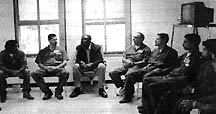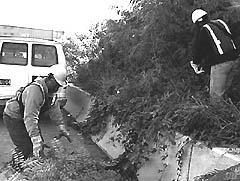|
FULTON - The D.O.C.S. Years 1975-2000
In November, 1975, Fulton Community Based Service Center was converted to the Fulton Correctional Facility. Under the direction of then Superintendent Luis Samuels, the facility commenced operation as a minimum security prison for one hundred and eighty female inmates. |  | Luis G. Samuel
1970-
1977 | Frank R. Headley
1977-78, 1993-97 |
Within one year, a component of male work release inmates was added, elacing Fulton in a unique
category of facilities housing a dual population of both sexes. The female population was provided with academic, vocational, and counseling programs; the male inmates were housed separately and were required to seek and maintain employment while re-establishing community ties. In December,
1977, Fulton reverted to a facility for female inmates alone with the focus of programming on pre-release services.
One year later the female population was transferred to Bayview Correctional Facility, and Fulton was designated to provide transitional services for male inmates with incomplete parole plans (open date cases).
In June 1980, Fulton was placed on the path which it has followed to the present day. During that month, the facility joined other facilities in New York City in providing only work release programs for male inmates.
 |  | Clifford Watterson
1979-80 | Ernest Sullivan
1980-81 |
Although the initial capacity was only two hundred inmates, it soon became clear that the burgeoning growth in population throughout the state system had also resulted in a large pool of inmates who were eligible for temporary release programs but for whom space was not readily available. Inmates who applied for participation in work release were placed on lengthy waiting lists, it was not uncommon for inmates to be released to parole supervision before they could be offered the transitional services provided in work release. In June 1983, despite some concerns regarding security and privacy issues, double bunks were installed and Fulton"s population doubled immediately. Those concerns proved to be unfounded, however, and the work release program flourished with a capacity of four hundred inmates.
Throughout the next several years, the overall growth in population escalated throughout the Department, and in 1985 a significant change in the eligibility requirements for temporary release programs took place. At this point, the maximum remaining sentence to earliest parole eligibility date for work release candidates was expanded to twenty-four months.  |  | William Gaines
1981-82 | Joseph V. Williams
1982-92 |
The number of candidates ready for transfer to work release facilities effectively doubled with the introduction of this measure, and the Department began to seek viable solutions which would reduce the backlog of applicants and to make the program more accessible.
Between 1990 and 1993, two dramatic initiatives were introduced to accommodate the needs of population. The first of these was the double encumbering of bed space; two hunates would now be assigned a single bed allocation. Programs and furloughs were scheduled so that one inmate would
be working or at home with his family while the other hunate would physically occupy the bed in the facility. The second initiative-was the innovation of day reporting; inmates with satisfactory adjustment and with less than six months to parole eligibility could now be allowed to reside full time with their families with the obligation to report to the facility for structured monitoring conducted by Counseling and Parole staff With the implementation of these two strategies, die population at Fulton surged to
exceed one thousand ininates.
In 1994,. the law governing access to Temporary Release programs was significantly changed. Inmates with conviction or documented histories of violent behavior were excluded from participation. |  | Napoleon Mitchell
1997-99 | Brandt L. Kehn
1999 -- |
An immediate and sustained drop in the work release population occurred statewide.
At Fulton, the population was reduced by approximately two thirds.
The significant reduction in the number of inmates in work release has led us into a new period of exciting development. Existing programs have been reevaluated and refined, and new programs have been established to focus on providing each participant with all of the transitional support needed in successfully -returning to society. The structure of work release has been revamped to, place more responsibility on each inmate for his individual program. Eligibility for extended furlough privileges, and eventually for Day Reporting, are now based more on merit than on basic time criteria. From the moment of reception through release to parole supervision, each inmate must remain gainfully employed, must participate in recommended treatment modalities, and must reintegrate with his
family in a positive manner in order to progress.
 | | FULTON RELAPSE SESSION |
Earlier this year, Fulton was designated to conduct the only Relapse Program offered to male work release participants in the state system. The Alcohol and Substance Abuse Treatment staff were relocated in newly constructed program space on the Relapse Unit, and meeting rooms were
designed to accommodate groups conducted by in house staff as well as by appropriate community agencies.
Narcotics Anonymous meetings, Network m the Community sessions, and job development seminars are now routinely held on the unit, and a new family services program is in development for implementation in the very near future. A relapse Team Case Conference system has been established
to ensure that each participant is monitored at regular intervals by Counseling, Parole, Security, Mental Hygiene, and Medical Staff thoughtout treatment. Inmates who successfully complete this program are released with a discharge plan which includes a summary of participation and
recommendations for aftercare upon return to work release status.
As Fulton celebrates its twenty-fifth year of providing services to our community, the facility has reflected the spirit of renewal and rebirth that has been going on in the Bronx, especially during the last decade.
 | | Community service scene [from Fulton CF 25th anniversary booklet inside back cover]. |
Just as the surrounding neighborhood has re-emerged as a thriving environment in which to live and work, Fulton has undergone major physical changes not only to correct structural deficiencies but also to improve the quality of work life. Superintendent Brant Kehn has spearheaded a campaign to re-established old ties and to develop new ones in the area. The community Advisory Board has been reactivated and its membership expanded, a concentrated effort to recruit community agencies to come into the facility to provide services has enhanced our programs, our staff has made
numerous presentations at local schools, churches, and social service organizations, and our community crews have been increased. The invaluable efforts of the Staff, volunteers, and inmates over the last quarter century have provided a strong foundation upon which we look forward to building well into the new millennium.
|

